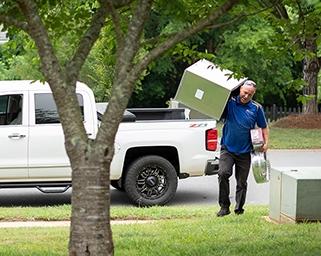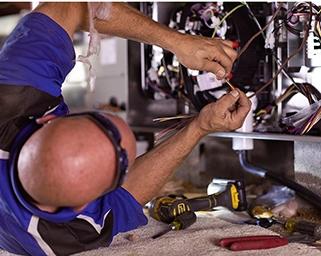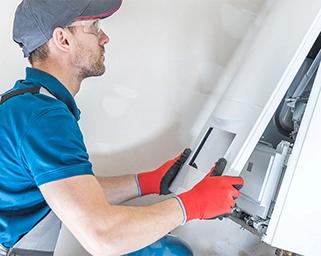Top 5 Signs You Need to Schedule Furnace Repair
Key takeaways: If your furnace is acting up, it could be a sign it needs repairs.

By Tom Moor
Few things are worse than waking up to a cold house in the middle of winter. Luckily, furnaces usually give you warning signs before they fail. Catching them early saves money, prevents breakdowns, and keeps your family safe. Here are the top signs your furnace may need repairs.
1. Trouble starting or staying on
A properly running furnace should kick on quickly when your thermostat calls for heat. If it hesitates, needs several restarts, or shuts down before finishing a cycle, it’s a sign something’s wrong. Common culprits include ignition issues, worn wiring, or faulty safety switches. Older furnaces with pilot lights are especially prone to these startup problems.
Pro Tip: It sounds simple, but sometimes the fix is as easy as checking your thermostat settings. If the furnace still won’t start, it’s time to call a professional. An HVAC dealer will test the ignition system, check the electrical components, and rule out safety switch malfunctions.
2. Weak or uneven airflow
Does one room feel warm and cozy while another stays cold? Weak airflow usually points to issues with the blower motor, leaky ductwork, or clogged filters. Without strong, consistent airflow, your furnace runs longer cycles, which wastes energy and causes increased wear and tear.
Pro Tip: Start by replacing your furnace filter and see if the airflow improves. If not, call a technician. They’ll inspect the blower motor, check for obstructions, and look for duct leaks that may be wasting heat.
3. Strange noises during operation
A furnace should run quietly in the background. If it keeps you up at night with banging, rattling, screeching, or grinding noises, it usually means loose parts or mechanical issues.
Pro Tip: Pay attention to when the noise happens and what it sounds like. It might seem silly jotting it down, but it helps your tech diagnose the problem faster. Many problems can be fixed before they cause more extensive damage or a complete breakdown.
4. Unusual smells or carbon monoxide alerts
Some furnace issues don’t just affect comfort – they put your safety at risk. Persistent burning odors may indicate electrical issues, while musty smells could signal mold in the ductwork. The most serious danger, though, is carbon monoxide (CO). A cracked heat exchanger can allow this odorless, invisible gas to leak into your home.
Pro Tip: If you smell rotten eggs or your CO detector goes off, shut down your furnace immediately, leave the home, and call the gas company. For other odors, contact an HVAC technician. They can inspect the wiring, clean necessary components, and test for cracks in the heat exchanger to keep your system – and your family – safe.
5. Furnace short cycling
Is your furnace turning on and off more frequently than normal? That’s called short cycling, which can cause a host of problems. Not only does it waste energy, but it also puts unnecessary stress on the system. Common causes of short cycling include dirty filters, thermostat malfunctions, or an oversized furnace.
Pro Tip: Replace your air filter first to rule out airflow restriction. If the short cycling continues, call a professional. They’ll run diagnostics on the thermostat, examine the flame sensor to check if it’s dirty or faulty, and determine if the system is improperly sized for your home.
The importance of regular furnace maintenance
While catching furnace problems early is important, the best defense is preventing them in the first place. That’s why a yearly tune-up is so important.
Think of a fall furnace tune-up like an oil change for your car – it’s a small step that prevents bigger headaches later by preparing it for the heavy workload of winter. During a maintenance visit, a technician will:
- Inspect and clean burners for safe, efficient combustion
- Replace or clean the air filter to maintain airflow
- Check and calibrate the thermostat for accurate temperature control
- Inspect the heat exchanger for cracks or damage (safety check)
- Inspect and tighten electrical connections, wiring, and terminals
- Test carbon monoxide levels and the ventilation system
- Inspect the flue and vent system for blockages or leaks
Regular maintenance not only reduces breakdowns but also helps lower energy costs and extends the life of your furnace. Skipping it can lead to various issues including short cycling, poor airflow, and unexpected shutdowns.
When a furnace repair might not be enough
It’s never fun to think about replacing a furnace, but doing so on your own terms is a lot less stressful than being left in the cold after a breakdown. Common signs it may be time to replace your furnace include:
- Your system is 15-20 years old or older
- Repairs are becoming more frequent and costly
- Energy bills keep climbing despite regular maintenance
- Your furnace struggles to maintain consistent comfort
- You’ve experienced major component failures, such as a cracked heat exchanger
Contact an American Standard® dealer for reliable furnace repair service
If you notice any of these signs, don’t wait for a complete breakdown. Partner with a trusted American Standard® dealer for expert, reliable furnace repair service. Whether it’s a small repair, a full system replacement, or routine maintenance, an American Standard dealer will make sure your home stays safe and comfortable all winter long.
Author: Tom Moor
Expert review by Amy Gulas, Product Manager, Furnaces
Related articles



